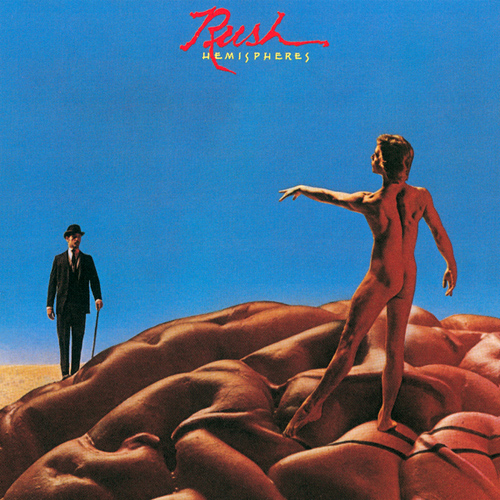
Hemispheres (1978)

1.Cygnus X-1 Book II
2.Circumstances
3.The Trees
4.La Villa Strangiato
Here we come to a rather divisive point in the catalogue. Among the fanbase, Hemispheres is nearly sacred—regularly named a top-five release, a crowning achievement, a magnum opus. And yet, for some others, the reaction is more muted. There’s no denying the technical prowess or the ambition. The playing is superb. The structure is airtight. The production is crisp and thoughtful. But for all that, it doesn’t quite soar.
Much of that ambivalence stems from side one, which is given over entirely to Cygnus X-1 Book II: Hemispheres. This was only the second time the band had committed a full album side to a single piece, and once again, they reached for the stars—mythological ones, in this case. Supposedly a continuation of Cygnus X-1 from the previous album, though one would be hard-pressed to find any lyrical through-line between them. If Book I was a black hole space voyage, Book II is an abstract parable about the balance between logic and emotion. There’s a god of reason. A god of feeling. And a new deity, Cygnus, who somehow unites the two.
The problem isn’t the concept. Prog has always thrived on the obscure and the allegorical. The issue is the execution. For all its thematic weight, the piece rarely takes off musically. Aside from a recurring riff that provides some structure, the track meanders. Dynamics remain largely static. It lacks the sense of drama or adventure that defined earlier long-form tracks like 2112. One can’t help but wonder whether this might have worked better condensed into a more focused seven or eight-minute suite. Still, the band was applauded for its ambition. Sometimes that's all it takes.
Fortunately, side two is another story entirely. Circumstances kicks things off with a surprising dose of punchy directness. Clocking in at under four minutes, it’s one of the most compact tracks in the band’s repertoire, and yet it packs an impressive amount of melodic invention into its runtime. The little xylophone break in the middle is a particularly charming touch. It’s the sort of song that makes you wonder why it wasn’t given more love in their setlists—though it would finally reappear live some thirty years later. Next up is The Trees. A fan favorite, and rightly so. The premise—anthropomorphized trees arguing over equality—is admittedly a bit whimsical, but musically it’s pure gold. Acoustic intro, dramatic crescendos, tight interplay between the trio. Everything one could want from a mid-era cut.
And then there’s La Villa Strangiato. Subtitled “An Exercise in Self-Indulgence” and wearing the label proudly, this was the band’s first full-length instrumental, and it remains one of their most beloved. Where the lyrics may have occasionally strained credibility, the musicianship here speaks for itself. It’s exhilarating, unpredictable, and dazzlingly complex. There’s a reason guitarists and drummers the world over have tried—and mostly failed—to master its shifting time signatures and hairpin turns. It’s less a song than a sonic rollercoaster. And it’s glorious.
Hemispheres marked the end of an era. The band had taken progressive rock about as far as it could go before risking collapse under its own weight. The popularity continued to rise, albeit gradually. The arenas were getting larger. But the next record would signal a deliberate shift in approach. As for Hemispheres? A record of immense polish and rare discipline. For many, it’s the pinnacle. For others, a well-constructed monument to excess. Either way, it’s a record that commands attention.
Go back to the main page
Go To Next Review